If you click on a link and make a purchase we may receive a small commission. Read our editorial policy.
The Fantastic Four's Human Torch wasn't a womanizer until the '00s - but somehow it stuck so much Marvel Studios is fighting back in First Steps
How Chris Evans and the Ultimates creators changed Fantastic Four's Human Torch into a womanizer.
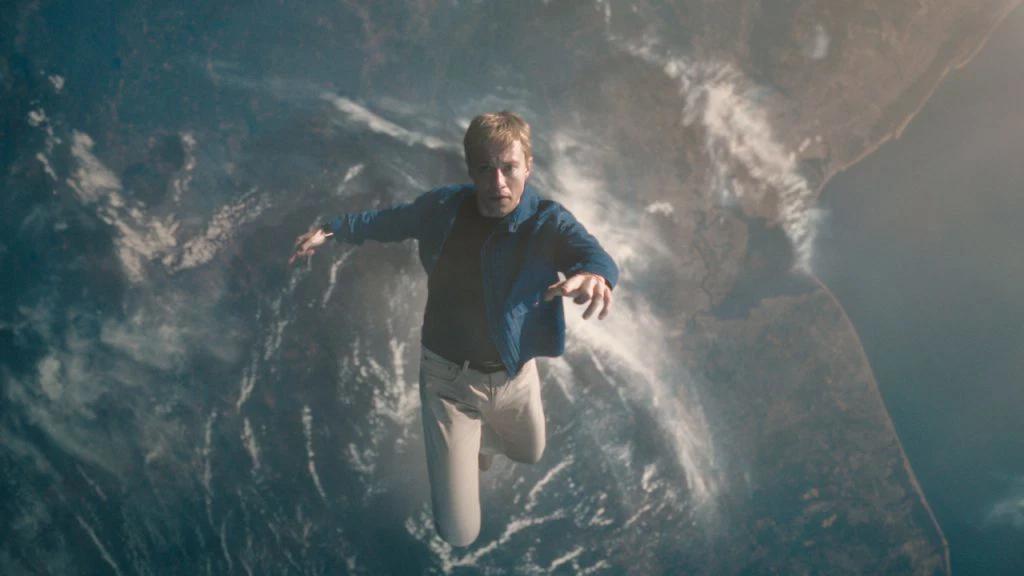
Popverse's top stories
- Hazbin Hotel creator Vivienne Medrano knows the secret that can make Halloween bigger than Christmas
- Here's how to watch all the New York Comic Con 2025 panels
- We almost saw the Young Avengers in the MCU, but Kang stuff changed everything
On April 10, 2025 Joseph Quinn made waves when he told Entertainment Weekly that his version of the Human Torch wouldn’t be a womanizer. Quinn, who will be starring in Marvel Studios’ Fantastic Four: First Steps, believes that the character needed to grow out of his womanizing persona.
"He's a man that leads with a lot of bravado, which can be an affront sometimes. But also he's funny," Quinn says in an EW interview. "Myself and [Marvel Studios boss] Kevin [Feige] were speaking about previous iterations of him and where we are culturally. He was branded as this womanizing, devil-may-care guy, but is that sexy these days? I don't think so. This version of Johnny is less callous with other people's feelings, and hopefully there's a self-awareness about what's driving that attention-seeking behavior."
Anytime the films change a piece of comic book lore, the reaction online is loud and fierce. This was no exception, with articles and social media posts decrying the change. Many have accused Marvel Studios and Quinn of “being woke,” forgetting the most important trait of the character. One particular Facebook thread had numerous users saying that Johnny wasn’t Johnny unless he was a womanizer. Multiple people mentioned the original comics, stating the film should’ve stuck with the source material.
This outrage assumes that Johnny Storm was a womanizer in the original Fantastic Four comics, which isn’t true. Don’t get me wrong, the character is certainly portrayed as a womanizer in modern comics, but for decades that wasn’t the case.
When did Johnny Storm become a womanizer, and how important is it to his character? Why do we look at Johnny Storm as a womanizer and not someone like Peter Parker, who has also dated a lot of women? Let’s take a journey through Fantastic Four history and examine these questions…
What is a womanizer?
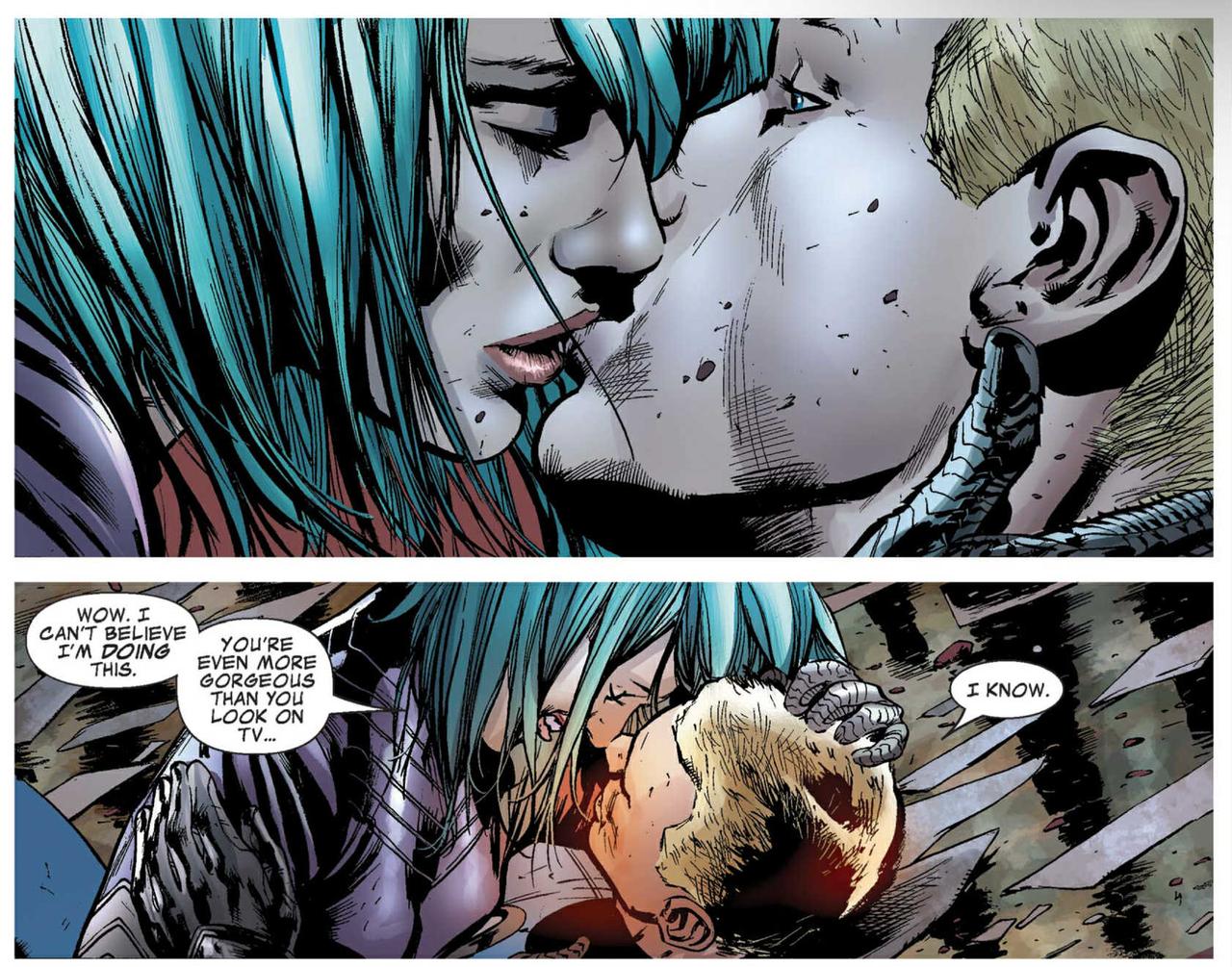
Before we examine this question, it’s important to establish what a womanizer is. Merriam-Webster’s Dictionary defines womanizer as someone who pursues casual sexual relationships with multiple women. In other words, a womanizer doesn’t seek monogamous and committed relationships. Dating a lot of women isn’t enough to make someone a womanizer, as long as those relationships were serious, and as long as they didn’t overlap.
Characters like James Bond, Sam Malone, and Barney Stinson would be considered womanizers due to their treatment of women. Characters like Peter Parker, Dick Grayson, and Frasier Crane have also dated a lot of women, but they wouldn’t be considered womanizers because they were committed to the relationships they were in.
First steps and first loves
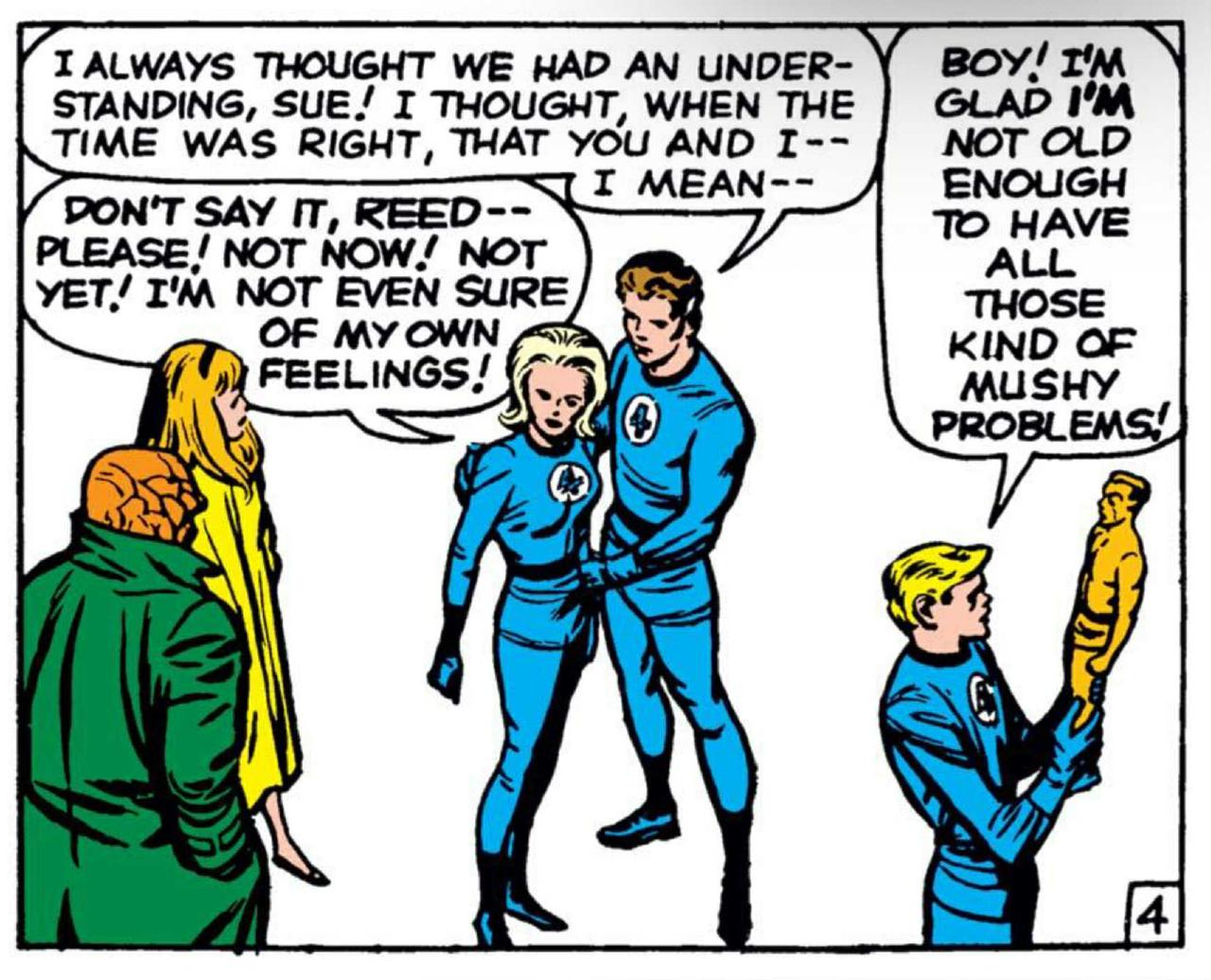
Right off the bat, I’ll start by saying that there are zero signs of Johnny Storm being a womanizer in Stan Lee and Jack Kirby’s original Fantastic Four run. The original mome-year run of 102 issues that serve as the foundation for the FF mythos don’t contain any signs of Johnny Storm being a womanizer. If something wasn’t included in what’s considered the FF bible, how important can it really be to the character?
In the early years Johnny’s character was the kid brother. He was youthful and mischievous. He had a sense of innocence that the stoic Reed and the grumpy Ben didn’t have. Women and relationships seemed to be the furthest thing from Johnny’s mind.
When we first meet Johnny Storm in Fantastic Four #1 (1961), he tells a buddy, “There’s only one thing in the world that interests me more than cars.” He then flames on and flies away when he sees Reed’s 4 flare in the sky. “Remember me saying there was only one thing I care about more than cars? Well, this is it,” Johnny says as he flies off. If this scene was in a modern comic, you would probably expect him to mention girls. Heck, if this scene had any other cis teenage boy, you would probably expect them to mention girls.
Fantastic Four #10 (1962) contains a scene where Reed Richards and Sue Storm discuss the current state of their relationship. As Reed and Sue have their soap opera moment, Johnny stands to the side and remarks, “Boy! I’m glad I’m not old enough to have all those kind of mushy problems!” This is the kind of remark you would expect from an eight-year-old boy, not a high school student. However, it speaks the way Johnny was characterized as the team’s little brother, and his lack of interest in all things romance.
Strange Tales #103 (1962) is the first time Johnny shows any romantic interest towards a girl. The Human Torch is transported to the Fifth Dimension, where he meets a freedom fighter named Valeria. Johnny is drawn to her beauty, and when he returns to Earth he finds himself constantly daydreaming about her. “Gosh! That Valeria was so beautiful! I’ll never be able to get her out of my mind,” Johnny muses.
Fantastic Four #16 (1963) has a similar story beat. When the Fantastic Four find themselves stranded in the Microverse, Johnny and the young Princess Pearla display signs of puppy love.
Johnny Storm was seen with a girlfriend for the first time in Strange Tales #113 (1963). Dorrie Evans became a regular supporting character in the Strange Tales comic anthology, giving the Human Torch’s solo feature some narrative conflict. Unlike Peter Parker and his girlfriends over in Amazing Spider-Man, none of Johnny’s relationship drama with Dorrie had anything to do with other girls. Instead, Dorrie didn’t like Johnny’s showboat nature, and constantly discouraged him from using his powers.
The closest Johnny came to exhibiting womanizing behavior during this period was Strange Tales #116 (1963), where he makes a play for Ben Grimm’s girlfriend Alicia Masters. However, Johnny was being mind controlled by the Puppet Master, who was trying to instigate a fight between the Human Torch and the Thing. In fact, Alicia found Johnny’s inappropriate romantic overtures so out of character that she quickly deduced that he was being controlled. That tells you a lot about how Johnny was viewed back then. This incident has some unintentional irony when you realize that Marvel wrote an actual Johnny/Alicia/Ben love triangle decades later.
Fantastic Four #45 (1965) introduced Crystal, a member of a race of beings known as the Inhumans. For Crystal and Johnny, it was love at first sight. Stan Lee and Jack Kirby kept the two apart for some time by placing an unbreakable barrier between the Inhuman’s kingdom and our world. This gave readers multiple issues of Johnny and Crystal longing for one another.
Once Crystal was able to escape the barrier, she and Johnny were inseparable. The two were very affectionate, to the point of obnoxiousness. Occasionally there would be relationship drama over things like Johnny telling Crystal battling villains was too dangerous for her. However, it was clear that Johnny was committed to her.
By the time Jack Kirby left the title after Fantastic Four #102 (1970), Johnny was a fully developed character. He was impulsive, mischievous, and quick tempered. He fell for a few different women but was committed to Dorrie and Crystal when he was with them. Johnny Storm was many things in the original Stan Lee and Jack Kirby run, but he was never a womanizer.
My best friend’s girl
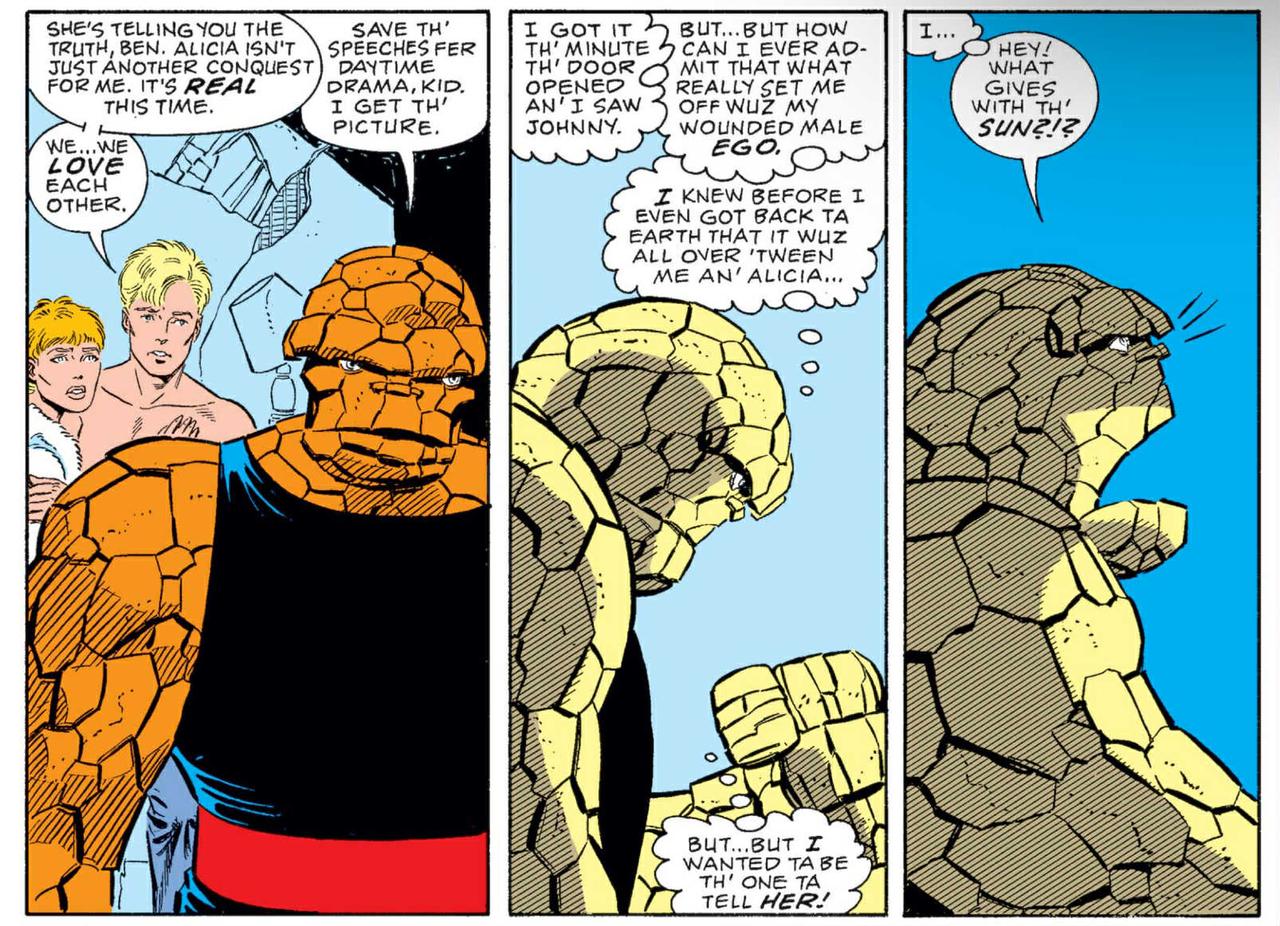
Crystal would eventually leave Johnny for Quicksilver. The Human Torch spent the next decade with a variety of love interests like Frankie Raye, Julie Angel, and an alien healer named Zsaji.
Reed and Sue were happily married, and Ben was in a committed relationship with Alicia, which meant all the relationship soap opera storylines went to Johnny. The Human Torch appreciated beautiful women and wasn’t shy about saying so, but when he was in a relationship, he was committed. Yes, Johnny had a rotating door of love interests, but so did other Marvel characters like Peter Parker and Matt Murdock.
One of Johnny Storm’s most controversial romantic storylines began in Fantastic Four #265 (1984) when the Fantastic Four returned from a planet called Battleworld, while Ben Grimm chose to remain behind. Johnny began spending time with Alicia. It started off with them trauma bonding after Sue’s miscarriage in Fantastic Four #267 (1984), but it soon grew into more.
Fantastic Four #275 (1984) features the aftermath of their first night together, and Johnny immediately feels guilty. He’s torn between the growing bond he’s developed with Alicia and his loyalty to Ben. Alicia reminds Johnny that it was Ben’s choice to remain on Battleworld, and they shouldn’t let his memory stand in the way of their love.
Ben returns from Battleworld in Fantastic Four #277 (1985) and becomes furious when he finds Johnny at Alica’s place half-dressed. This creates a conflict that results in Ben temporarily leaving the Fantastic Four.
Johnny and Alicia’s relationship can be seen as evidence of him being a womanizer, but it’s important to note the intent. Johnny didn’t set out to steal his best friend’s girlfriend, and his feelings for Alicia were deep. Johnny also felt guilty and wrestled with his feelings.
Was it a skeevy thing to do? Yes, but Johnny was genuinely in love, and Ben was on another planet at the time, and he had told his teammates he wasn’t sure if he would ever return. It’s messy, it’s a soap opera, but I don’t know if I would call it womanizing.
Marital temptations
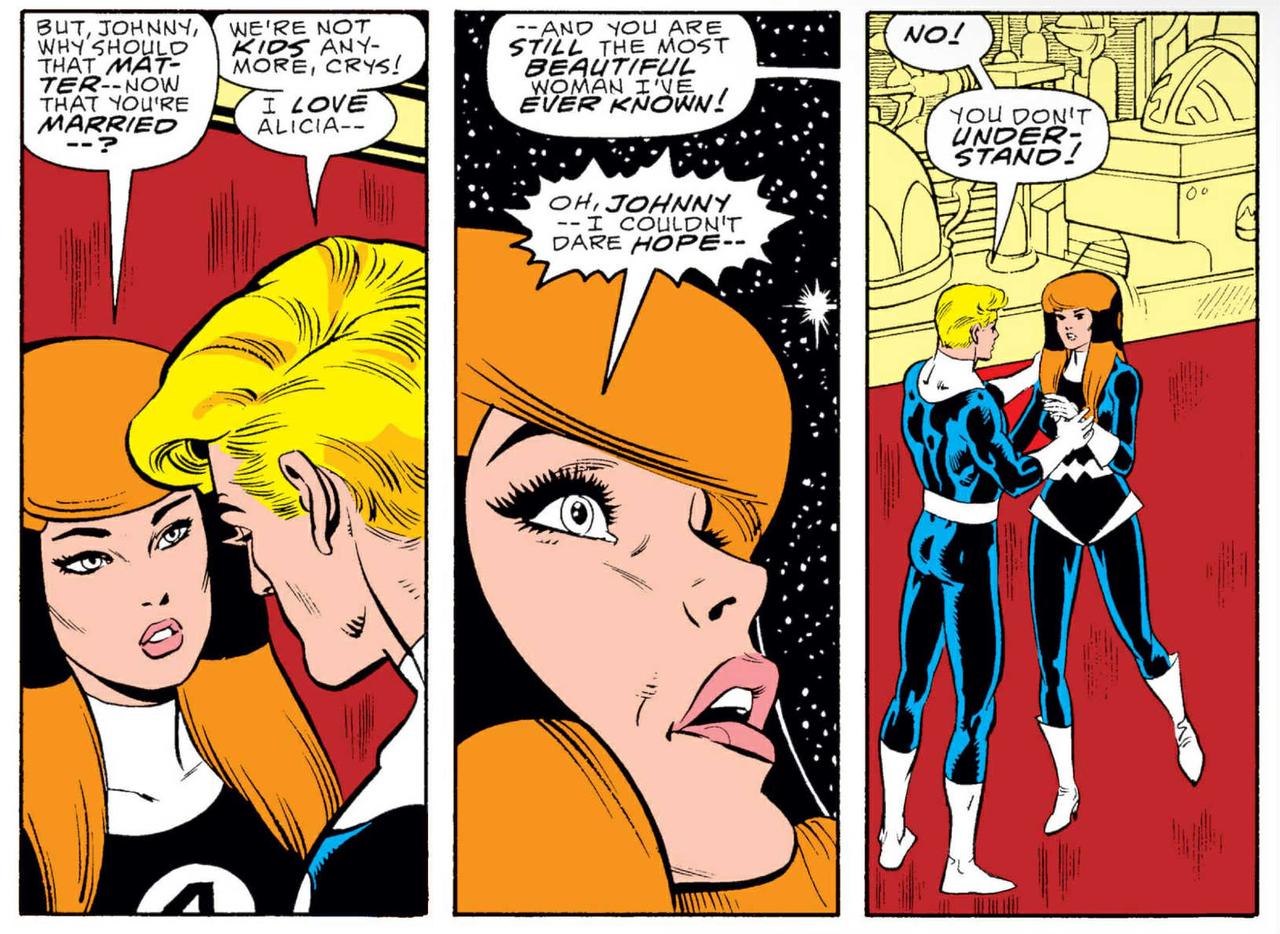
Johnny attempts to propose to Alicia in Fantastic Four Annual #19 (1985) and Fantastic Four #287 (1985) but is interrupted both times. The fact that they’ve only been a couple for less than 15 issues is a testament to how serious Johnny was about the relationship. He’s not trying to hold onto his bachelor lifestyle, and he’s ready to spend the rest of his life with one woman.
Alicia accepts Johnny’s marriage proposal in Fantastic Four #297 (1986) and the two are married in Fantastic Four #300 (1986). In one of Johnny’s more questionable moves, he asks Ben to be his best man, and surprisingly he accepts. If they were giving out awards for being a good sport, Ben would get a gold medal.
However, comic books are soap operas, and Johnny and Alicia’s marriage needed some tension. That tension came with the return of Crystal in Fantastic Four #305 (1987). Ben, who was through being a good sport, invites Crystal to rejoin the FF knowing it would be emotionally difficult for Johnny to have his ex by his side during the early days of his marriage.
Crystal was newly single after separating from Quicksilver, and it was clear she still carried a torch for Johnny. Crystal’s return reawakened Johnny’s feelings, and he found himself torn between his loyalty to his wife, and his heart. Johnny and Crystal both agonized over this for some time before they finally addressed their feelings in Fantastic Four #317 (1988). Johnny and Crystal admit that they’ve fallen in love with each other once again, but Johnny makes it clear that he won’t do anything to jeopardize his marriage.
“Every fiber of my being burns for you Crys – but I’m committed to ‘Licia. No matter how it hurts, I’m not a kid anymore. I’ve taken on adult responsibilities, and I won’t break the vows I made to my wife,” Johnny tells Crystal.
Some readers have described the situation with Johnny and Crystal as an emotional affair, and it’s not an entirely inaccurate assessment. While the two never gave into their feelings, Johnny’s heart was with a woman who wasn’t his wife. Crystal would eventually leave the team, putting an end to this subplot.
The Fantastic Four encounter Nebula in Fantastic Four #337-341, and Johnny finds his heart straying. While his feelings were never as intense as they were with Crystal, Johnny feels guilty over his attraction to Nebula. Johnny never acts on these feelings, but his emotional turmoil creates some tension between him and Alicia. The subplot is eventually forgotten.
Are Johnny’s feelings for Nebula and Crystal evidence that he’s a womanizer? It’s a grey area. While Johnny never acted on his feelings for either woman, his relationship with Crystal wasn’t appropriate. I don’t think we’ve reached Johnny’s womanizer persona yet, but these marital temptations are important things to note as we track his character’s evolution.
Life with Lyja
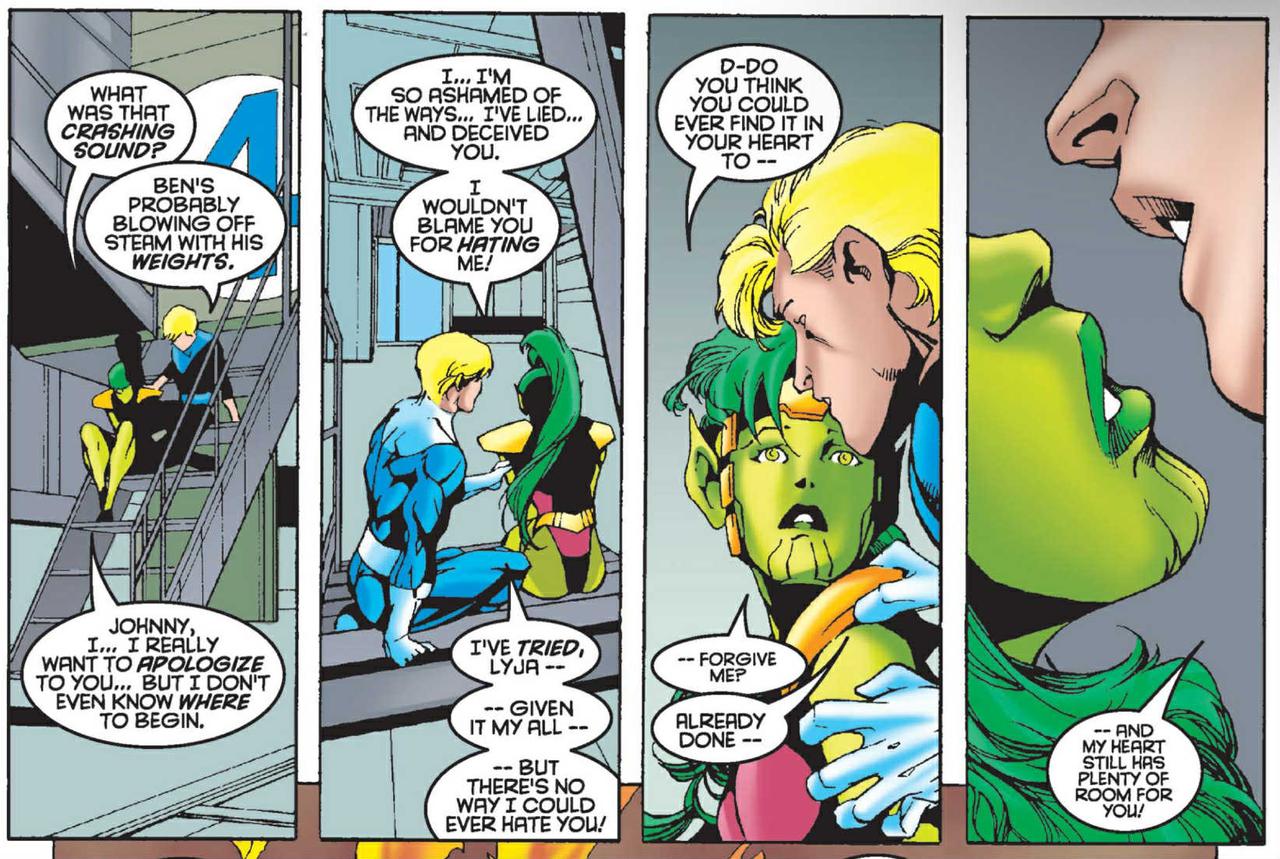
When Tom DeFalco took over writing duties for Fantastic Four, one of the first things he did was undo the Johnny and Alicia marriage. Fantastic Four #357 (1991) ends with a cliffhanger revealing that Alicia is actually a shapeshifting Skull named Lyja. The Skrulls had kidnapped the real Alicia while the Fantastic Four were on Battleworld and replaced her with Lyja. This means that the Alicia who romanced and married Johnny was actually a Skrull the entire time.
Lyja revealed that she was on an undercover mission to gather intel for the Skrull empire. She was originally going to masquerade as Ben Grimm’s girlfriend, but when the Thing remained on Battleworld she improvised and pivoted to Johnny. As her undercover mission progressed, Lyja found that her feelings for Johnny had become real.
The Fantastic Four rescued the real Alicia, but the aftermath of Lyja’s deception was felt for years. The real Alicia had spent years in suspended animation and was ready to resume her relationship with Ben. However, Ben had spent years seeing “Alicia” as Johnny’s wife, and his heart had moved on.
Johnny also had a hard time dealing with the fact that the real Alicia had no romantic feelings for him. She looked and sounded like the woman he had been married to for years, but she wasn’t. To complicate matters further, Lyja kept coming in and out of Johnny’s life. Johnny considered repairing his relationship with Lyja, but after she faked a pregnancy, he told her they were through.
After spending some time nursing his broken heart, Johnny began dating a woman named Laura Green. However, this turned out to be Lyja in disguise once more, hoping to stay close to Johnny. The Human Torch figured out the ruse on his own, and confronted Laura/Lyja in Fantastic Four #416 (1996). Johnny forgave Lyja, and the two of them passionately kissed.
However, Johnny and Lyja were separated when the FF became stranded in a pocket universe for the Heroes Reborn event. By the time the Fantastic Four returned to Earth-616 in 1998, Lyja had disappeared, leaving Johnny alone and unattached for the first time in years.
The Lyja era of Johnny’s life began in 1984 when she began masquerading as Alicia Masters and ended in 1998 when Johnny returned from the pocket universe. That’s 14 years where the Human Torch was committed to one woman (albeit one who was masquerading as multiple women). We could hardly call him a womanizer then. We’ve now gone through nearly 40 years of FF history and while Johnny’s love life is a mess, he’s not exactly a playboy.
So, when did Johnny become a womanizer?
The coming of Chris Evans

Johnny Storm’s womanizer persona slowly began to emerge in the early 2000s. The beginning of this persona can be chalked up to two things: the evolution of celebrity culture and Chris Evans.
The rise of tabloids and entertainment news shows led to society having a new relationship with celebrity culture. We don’t have the space to fully explore the topic here, but in short, the early 2000s saw figures like Paris Hilton becoming famous for being young, rich, and attractive. Tabloids would chronicle the exciting nightlife of movie stars, writing about club-hopping and casual flings.
Johnny Storm was young, attractive, impulsive, and unattached, making him the perfect Marvel character to use as a commentary on celebrity culture. If the Marvel Universe was the world outside your window, then surely one of the superheroes would be on TMZ and appear in the tabloids alongside Paris Hilton and the other celebrities. It wouldn’t make sense to use someone like Matt Murdock or Peter Parker in this role, but the FF have always been celebrities, and Johnny has always had that fun-loving personality.
There isn’t a specific issue where Johnny transforms into this celebrity persona. It’s a slow evolution throughout the early 2000s. For example, when a documentary crew begins filming the FF in Fantastic Four #9 (1998), Johnny is very eager to show off for the camera.
In New Warriors #3 (1999) Johnny enters his first relationship since Lyja when he begins dating the Atlantean Namorita. One of the reasons the two young heroes begin dating is because they enjoyed the attention the paparazzi gave them. Once again, this was a reflection of the changing celebrity culture. While Johnny never cheated on her, Namorita could probably be considered his first superficial relationship.
In 2005 20th Century Fox released Fantastic Four in theaters, which featured pretty boy Chris Evans as Johnny Storm. Evans’s version of Johnny Storm was an unapologetic womanizer who embraced his celebrity status. Throughout the 2005 film, we see countless girls fawning over Johnny, and Johnny happily returning their affection. He happily has casual sex with his ski partner after his powers make an impromptu hot tub in the snow. For better or for worse, Evans’s portrayal of the character went a long way in cementing Johnny’s status as a womanizer in the public consciousness.
However, it was still some time before that aspect of his character bled its way into the comics. Mark Millar and Bryan Hitch’s Fantastic Four run is where Johnny’s womanizing officially becomes part of his comic book persona. The run begins with Johnny entering a casual sexual relationship with a bank robber named Cindy. Johnny was trying to arrest her, but they wound up having sex instead. This becomes a running bit.
If there was any ambiguity over Johnny’s womanizer status, Fantastic Four #563 (2009) was the final nail in the coffin. The issue begins with Johnny sitting in bed with a Storm and Scarlet Witch cosplayer. The girls are hanging all over Johnny, there are empty wine bottles on the ground, and the dialogue implies that they had a threesome the night before.
Why do we think of Johnny as a womanizer
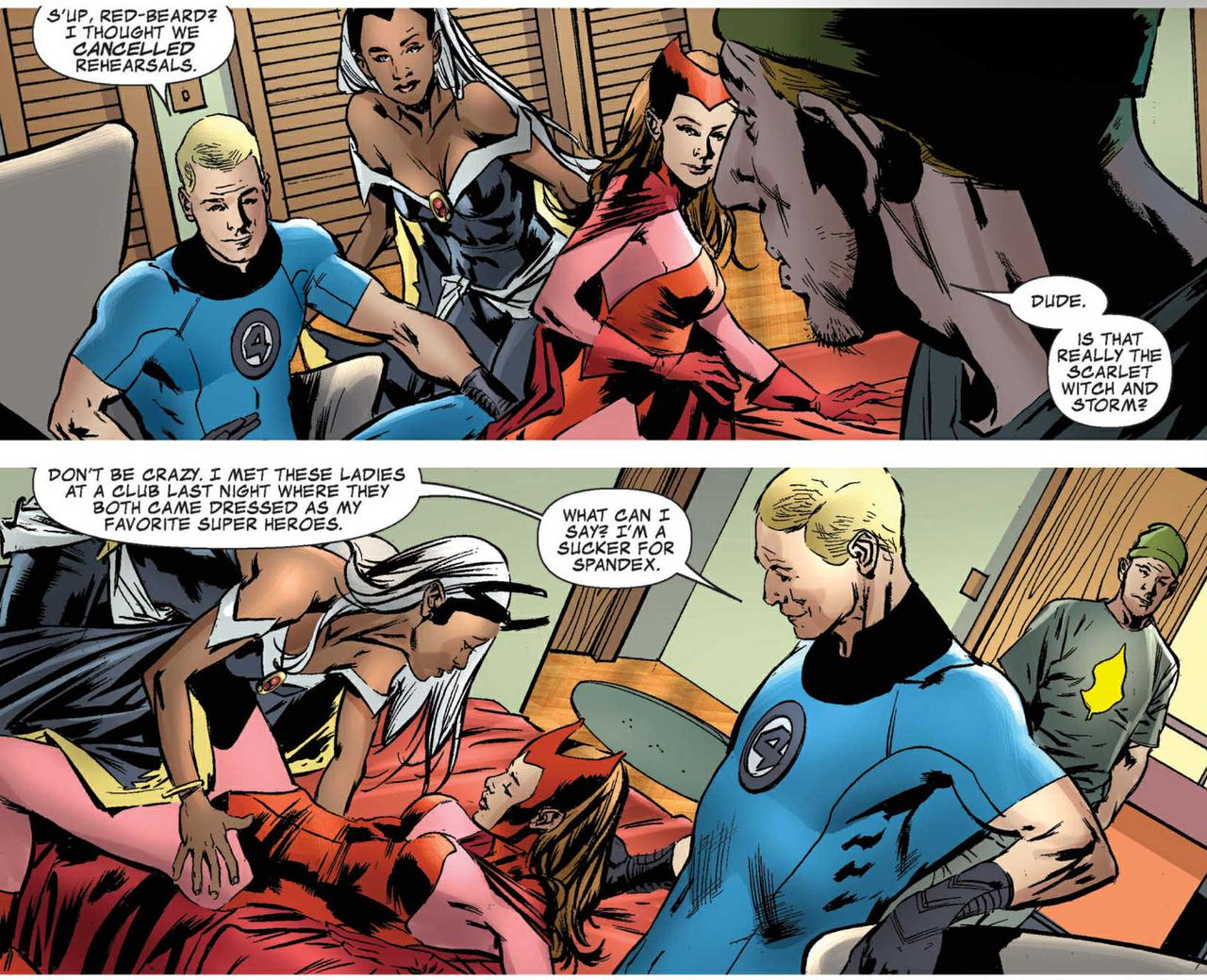
Johnny Storm has been around since 1961, and he’s been portrayed as a womanizer in the comics since around 2009. If we’re being generous, we could count Chris Evans’s portrayal and say 2005. This means that Johnny Storm has been a womanizer for 31 percent of his existence.
So, why do so many people think of it as his defining characteristic? Why do many readers have the perception that it’s been part of his character longer than it has?
I believe it’s partially the Mandela effect. When we think of Johnny’s personality in the classic comics, we remember that he was a young good-looking man, he had a big ego, he loved his fame, and he was impulsive. These are character traits that we typically associate with womanizers.
Celebrity culture is filled with famous people who enter casual sexual relationships. As Marvel began to depict Johnny as part of that celebrity world, our brains filled in the blanks, assuming Johnny was just as promiscuous as the movie and music stars featured on TMZ.
Love or hate the Tim Story Fantastic Four films, Chris Evans’s portrayal as Johnny Storm left an impression. Putting that with my previous examples, it’s easy to see how comic book readers might misremember Johnny Storm’s early history.
The fact that he’s had more love interests than his FF teammates add to the illusion. When we think of Johnny’s many girlfriends in comparison to Reed, Ben, and Sue, he does seem like a womanizer. In reality, it’s no different than characters like Peter Parker getting a new girlfriend every few years.
Johnny Storm has certainly evolved into a womanizer, but it’s ridiculous to call it his defining characteristic. How could something that has only been a part of the character for 31 percent of his existence be considered a defining characteristic?
The Johnny Storm of the Marvel Cinematic Universe won’t be a womanizer, but neither was the one written and illustrated by Stan Lee and Jack Kirby, so that’s just fine.
Want to know what's coming up next in pop culture? Check out Popverse's guides to:
Follow Popverse for upcoming event coverage and news
Find out how we conduct our review by reading our review policy
Let Popverse be your tour guide through the wilderness of pop culture
Sign in and let us help you find your new favorite thing.



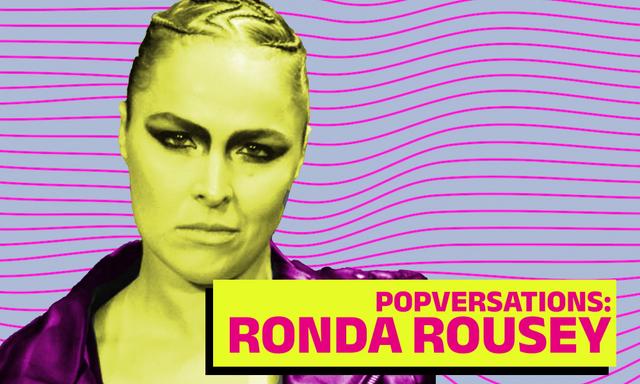
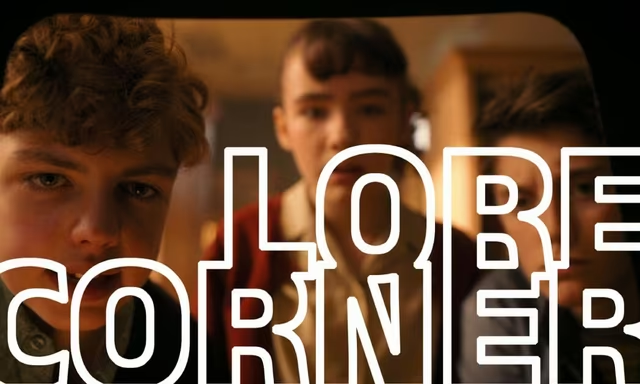
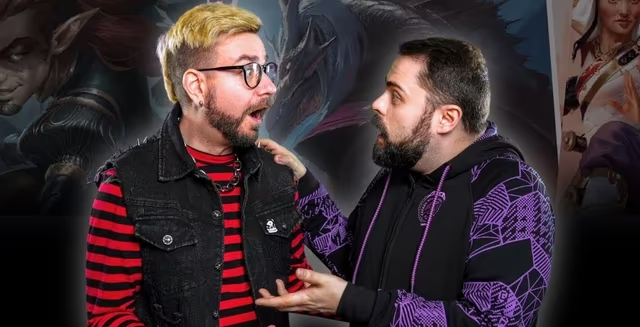
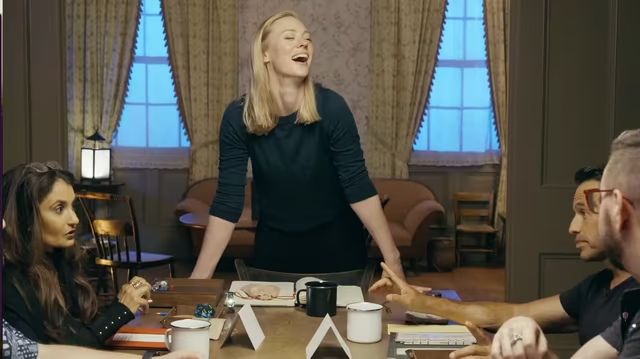

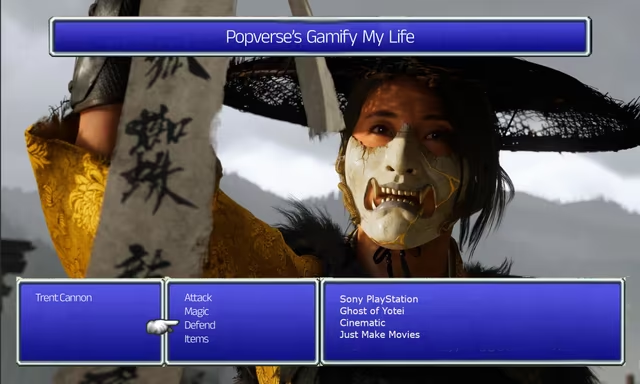
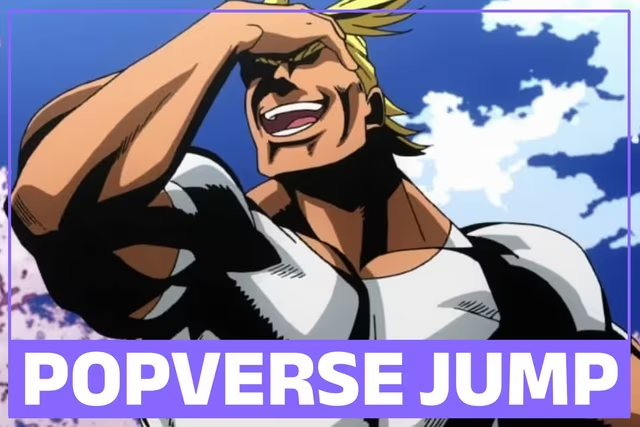






Comments
Want to join the discussion? Please activate your account first.
Visit Reedpop ID if you need to resend the confirmation email.